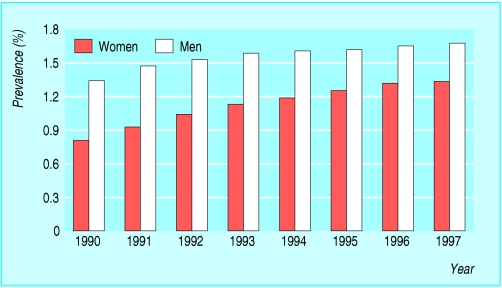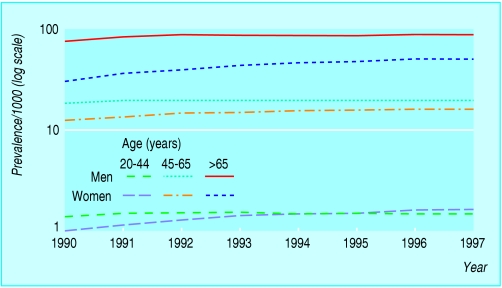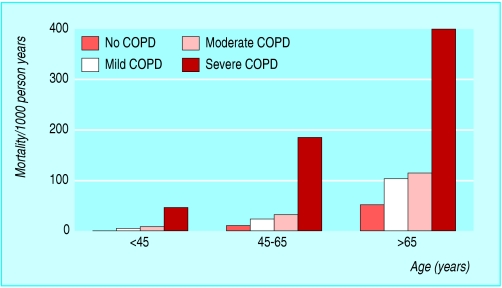Definition
In 2004, the UK National Institute for Clinical Excellence defined chronic obstructive pulmonary disease (COPD) as “characterised by airflow obstruction. The airflow obstruction is usually progressive, not fully reversible and does not change markedly over several months. The disease is predominantly caused by smoking.” COPD is the preferred umbrella term for the airflow obstruction associated with the diseases of chronic bronchitis and emphysema. These are closely related to, but not synonymous with, COPD.
Figure 1.
Table 1.
Definitions of conditions associated with airflow obstruction
| Chronic obstructive pulmonary disease (COPD)—Airflow obstruction that is usually progressive, not reversible, and does not change markedly over several months. It is predominantly caused by smoking |
| Chronic bronchitis—Presence of chronic productive cough on most days for 3 months, in each of 2 consecutive years, and other causes of productive cough have been excluded |
| Emphysema—Abnormal, permanent enlargement of the distal airspaces, distal to the terminal bronchioles, accompanied by destruction of their walls and without obvious fibrosis |
| Asthma—Widespread narrowing of the bronchial airways which changes its severity over short periods either spontaneously or after treatment |
Although asthma is associated with airflow obstruction, it is usually considered as a separate clinical entity. Some patients with chronic asthma also develop airflow obstruction that is relatively fixed (a consequence of airway remodelling) and often indistinguishable from COPD. Because of the high prevalence of asthma and COPD, these conditions coexist in many patients, creating diagnostic uncertainty. Other conditions also associated with poorly reversible airflow obstruction include cystic fibrosis, bronchiectasis, and obliterative bronchiolitis. Although these conditions need to be considered in the differential diagnosis of obstructive airways disease, they are not conventionally covered by the definition of COPD.
Figure 2.
Prevalence of diagnosed COPD in UK men and women during 1990-7
Epidemiology
Prevalence
Estimating and comparing the prevalence of COPD in different countries is complicated by differences in its precise definition and in the level of underdiagnosis. For example, in the United Kingdom mild COPD is defined as the ratio of forced expiratory volume in 1 second (FEV1) to the forced vital capacity (FVC) being < 0.7 and the FEV1 being 50-80% of the expected value. Other guidelines suggest slightly different spirometric values (see third article in this series).
Figure 3.
Prevalence of diagnosed COPD in UK men and women by age, during 1990-7
A national UK study reported an abnormally low FEV1 in 10% of men and 11% of women aged 16-65 years. Similarly, a study in Manchester found non-reversible airflow obstruction in 11% of adults aged > 45, of whom 65% had not had COPD diagnosed. In the United States the reported prevalence of airflow obstruction with an FEV1 < 80% of the expected value is 6.8%, with 1.5% of the population having an FEV1 < 50% of expected and 0.5% having more severe obstruction (FEV1 < 35% of expected). As in the UK, about 60% of those with airflow obstruction had not had COPD diagnosed. As much as 40-50% of the actual prevalence of COPD, based on measurements of ventilatory function, may be undiagnosed; many people present relatively late with moderate or severe airflow obstruction.
In England and Wales some 900 000 people have COPD diagnosed—so, after allowing for underdiagnosis, the true number with COPD is likely to be about 1.5 million. The mean age at diagnosis in the UK is roughly 67 years, and prevalence increases with age. COPD is more common in men than women and is associated with socioeconomic deprivation. The prevalence of diagnosed COPD in women is increasing (from 0.8% in 1990 to 1.4% in 1997), whereas in men it seems to have reached a plateau since the middle 1990s. Similar trends have been reported in the US. These trends in prevalence probably reflect sex differences in cigarette smoking since the 1970s.
This is the first in a series of 12 articles
Mortality
COPD is the fourth leading cause of death in the US and Europe. With the increase in cigarette smoking in developing countries, especially China, COPD is expected to become the third leading cause of death worldwide by 2020. During 2003, about 26 000 people died from COPD in the UK, accounting for 4.9% of all deaths, with 14 000 of these deaths occurring in men and 12 000 in women. These represent 5.4% of all male deaths and 4.2% of all female deaths.
Figure 4.
UK mortality from COPD since 1971
In the UK over the past 30 years, mortality from COPD has fallen in men and risen in women, and the sex difference in COPD deaths will probably disappear in the near future. In the US, mortality from COPD in women has also risen substantially, from 20.1 to 56.7 per 100 000 between 1980 and 2000, while in men the increase has been more modest, from 73.0 to 82.6 per 100 000. In 2000, for the first time, more women than men died from COPD (59 936 v 59 118). Mortality increases with age, disease severity, and socioeconomic disadvantage. On average, COPD reduces life expectancy by 1.8 years in the UK (76.5 v 78.3 years for controls)—mild disease reducing it by 1.1 years, moderate disease by 1.7 years, and severe disease by 4.1 years.
Figure 5.
UK mortality from COPD by socioeconomic status
Morbidity and economic impact
The morbidity and economic costs associated with COPD are high, largely unrecognised, and more than twice those from asthma. The impact on quality of life is particularly high in patients with frequent exacerbations, and even patients with mild COPD have an impaired quality of life.
Figure 6.
UK mortality from COPD by age and disease severity
Since the mid-1990s, emergency admissions for COPD have increased by at least 50%, so that in 2002-3 there were 110 000 hospital admissions for an exacerbation of COPD in England, accounting for 1.1 million bed days. At least 10% of emergency admissions to hospital are as a consequence of COPD, and this proportion is even greater during the winter. Most admissions are of people older than 65 years with advanced disease, who are often admitted repeatedly and use a disproportionate amount of resources. About 25% of patients with COPD diagnosed need admission to hospital, with some 15% of patients being admitted each year.
Figure 7.
Direct costs of COPD to the NHS
The impact in primary care is even greater, with 86% of care being provided exclusively by primary care. An average general practitioner's list will contain some 200 patients with COPD (even more in areas of social deprivation), although not all will have it diagnosed. On average, patients with COPD make six or seven visits annually to their general practitioner. Each patient costs the UK economy an estimated £1639 annually, equating to a national burden of £982m (€1450, $1741m). For each patient, annual direct costs to the NHS are £819, with 54% of this being due to hospital admissions and 19% due to drug treatment. COPD results in further costs to society in that roughly 40% of UK patients are below retirement age, and the disease prevents about 25% from working and reduces the capacity to work in a further 10%. Annual indirect costs of COPD have been estimated at £820 per patient and consist of the cost of disability, absence from work, premature mortality, and the time caregivers miss work.
Risk factors
Smoking
Cigarette smoking is clearly the single most important risk factor in the development of COPD. Current smoking is also associated with an increased risk of death. Pipe and cigar smoking also significantly increase morbidity and mortality from COPD, though the risk is less than for cigarettes. Around half of cigarette smokers develop some airflow obstruction, and 10-20% develop clinically significant COPD. Although smoking is the most important risk factor, it is not a prerequisite: COPD can occur in non-smokers with longstanding asthma or with α1 antitrypsin deficiency. Moreover, about 20% of COPD cases in men are not attributable to smoking.
Figure 8.
Current cigarette smoking is the most important risk factor for the development of COPD
A more contentious issue is the possible relation between environmental tobacco smoke and development of COPD: several case-control studies have shown a trend towards an increased risk of COPD with passive smoking. However, the adverse effect of maternal smoking on childhood ventilatory function is clearer: smoking during and after pregnancy is associated with reduced infant, childhood, and adult ventilatory function. Most studies have shown that the effects of antenatal smoking are greater in magnitude than, and independent of, the effects of postnatal exposure.
Figure 9.
Prevalence of airflow obstruction in US adults aged >17 years by smoking status
Air pollution
Urban air pollution may affect lung function development and consequently be a risk factor for COPD. Cross sectional studies have shown that higher concentrations of atmospheric air pollution are associated with increased cough, sputum production, and breathlessness and reduced ventilatory function. Exposure to particulate and nitrogen dioxide air pollution has been associated with impaired ventilatory function in adults and reduced lung growth in children. In developing countries indoor air pollution from biomass fuel (used for cooking and heating) has been implicated as a risk factor for COPD, particularly in women.
Occupation
Intense prolonged exposure to dusts and chemicals can cause COPD independently of cigarette smoking, though smoking seems to enhance the effects of such occupational exposure to increase the risk of developing COPD. About 20% of diagnosed cases of COPD are thought to be attributable to occupation; in lifelong non-smokers this proportion increases to 30%. Exposure to noxious gases and particles—such as grain, isocyanates, cadmium, coal, other mineral dusts, and welding fumes—have been implicated in the development of chronic airflow obstruction. Thus, a full chronological occupational history should be taken, as relevant occupational exposures are often missed by clinicians.
α1 antitrypsin deficiency
The best documented genetic risk factor for COPD is α1 antitrypsin deficiency. However, this is rare and is present in only 1-2% of patients with COPD. α1 antitrypsin is a glycoprotein responsible for most of the antiprotease activity in serum. Its gene is highly polymorphic, but some genotypes (usually ZZ) are associated with low serum concentrations (typically 10-20% of normal). Severe deficiency of α1 antitrypsin is associated with premature and accelerated development of COPD in smokers and non-smokers, though the rate of decline in lung function is greatly accelerated in those who smoke.
The α1 antitrypsin status of patients with severe COPD who are less than 40 years old should be determined since over half of such patients have this deficiency. Detection of such cases identifies family members who will require genetic counselling and patients who might be suitable for future potential treatment with α1 antitrypsin replacement.
The ABC of chronic obstructive pulmonary disease is edited by Graeme P Currie, specialist registrar, Respiratory Unit, Aberdeen Royal Infirmary, Aberdeen. The series will be published as a book by Blackwell Publishing in autumn 2006.
The figure of a COPD patient wearing an oxygen facemask was supplied by Mediscan. The figures of prevalence of COPD in UK men and women and of deaths from COPD by age and disease severity are adapted from Soriano JB, et al, Thorax 2000; 55: 789-94. The data for the figures of UK mortality from COPD and of mortality from COPD by socioeconomic status are from Mortality statistics: cause. Review by the registrar general on deaths by cause, sex and age, in England and Wales, 2003. London: Office for National Statistics, 2004. The data for the diagram of management costs of COPD are from Britton M, Resp Med 2003;97(suppl C): S71-9. The data for the figure of prevalence of airflow obstruction by smoking status are from Mannino DM, et al, Arch Intern Med 2000; 1601683-9.
Competing interests: GPC has received funding for attending international conferences and honoraria for giving talks from pharmaceutical companies GlaxoSmithKline, Pfizer, and AstraZeneca.
References
- • Anto JM, Vermiere P, Vestbo J, Sunyer J. Epidemiology of chronic obstructive pulmonary disease. Eur Respir J 2001;17: 982-94 [DOI] [PubMed] [Google Scholar]
- • Britton M. The burden of COPD in the UK: results from the confronting COPD survey. Respir Med 2003;97(suppl C): S71-9 [DOI] [PubMed] [Google Scholar]
- • Pride NB, Soriano JB. Chronic obstructive pulmonary disease in the United Kingdom: trends in mortality, morbidity and smoking. Curr Opin Pulm Med 2002;8: 95-101 [DOI] [PubMed] [Google Scholar]
- • National Collaborating Centre for Chronic Conditions. National clinical guideline on management of chronic obstructive pulmonary disease in adults in primary and secondary care. Thorax 2004;59(suppl 1): 1-3, 192-4 [PMC free article] [PubMed] [Google Scholar]
- • Chapman RS, He X, Blair AE, Lan Q. Improvement in household stoves and risk of chronic obstructive pulmonary disease in Xuanwei, China: retrospective cohort study. BMJ 2005;331: 1050-2. [DOI] [PMC free article] [PubMed] [Google Scholar]












